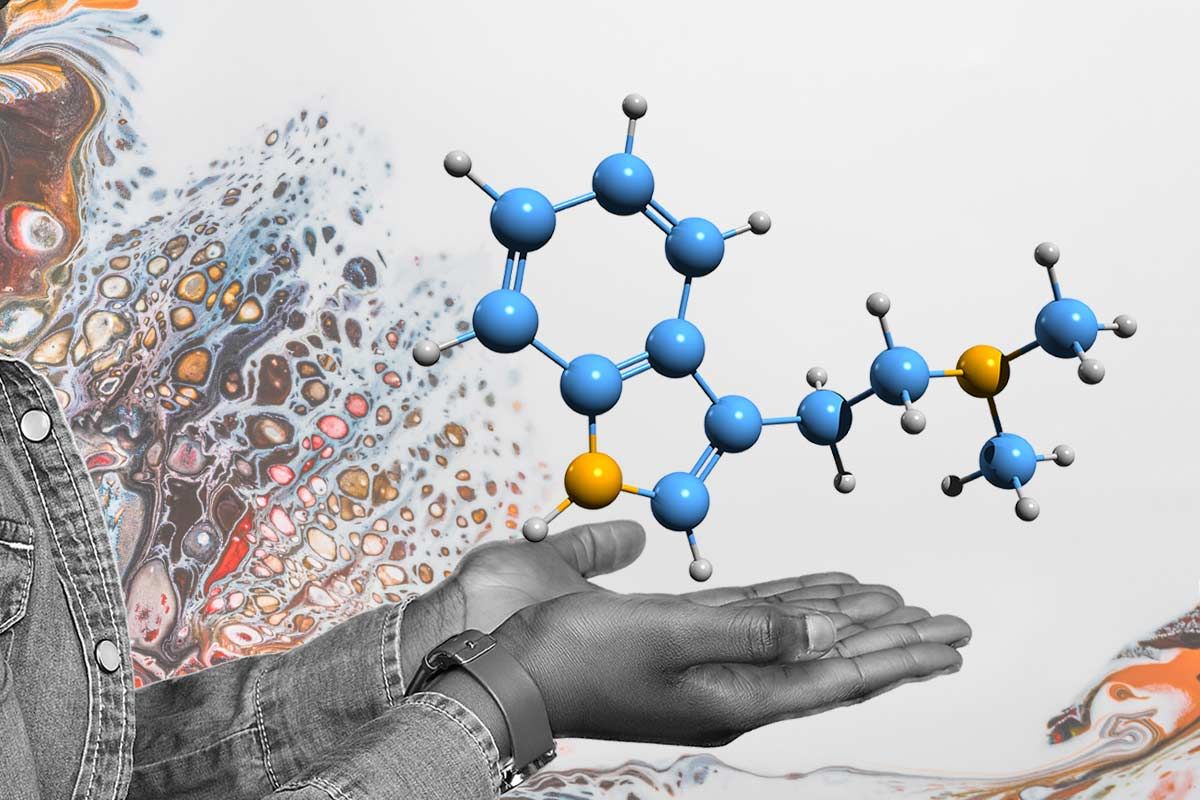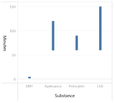Synthetic DMT is a powerful psychedelic with intense but usually short-lasting effects. Interestingly, the bodies of humans and other animals already produce small amounts of DMT (N,N-dimethyltryptamine), but its biological role is controversial. The potential of synthetic DMT as a therapeutic might be promising but is still largely unexplored.
DMT is a powerful psychedelic. It is one of the psychoactive ingredients in ayahuasca, a ceremonial drink that has long been brewed by some Amazonian peoples [1]. DMT (N,N-dimethyltryptamine) was first synthesized by chemist Richard Manske in 1931, but its psychoactive qualities were not discovered until 1956 after experiments by chemist Stephen Szara [2]. Once DMT was synthesized, it became possible to take it through inhalation or intravenously.
Naturally Found in Humans
One major difference between DMT and most other psychedelics is that it already seems to be found naturally in humans and at least some other animals [2]. There has been a lot (a lot) of speculation about why humans might endogenously produce DMT. Some research has shown correlation between reports of DMT experiences and near-death experiences [1], although other research seems to show that humans do not naturally produce enough DMT to create visions similar to near-death experiences [3]. Some researchers have hypothesized that endogenous DMT plays a role in many psychological states, including dreams, psychosis, or even general waking reality [4,5]. Yet DMT might also just be a by-product from enzymes performing other functions in the body [6].
Some Enzymatic Transformations From L-Tryptophan
Many people have speculated that the pineal gland has a special relationship with DMT, but there only seems to be limited research supporting this claim. Studies of rats without pineal glands have shown that their brains continue to produce DMT [7]. In the bodies of humans, INMT {indolethylamine-N-methyltransferase} is vital to the biosynthesis of DMT, and INMT mRNA has been found in several areas of mammal bodies besides the pineal gland. (However, INMT might have multiple roles in the human body. It also interacts with sulfides and the mineral selenium.) There is a possibility that humans create DMT in amounts similar to some neurotransmitters.
Follow your Curiosity
Sign up to receive our free psychedelic courses, 45 page eBook, and special offers delivered to your inbox.Some research has shown that DMT interacts with the well-known 5HT2A serotonin receptors on human neurons [6]. The 5HT2A receptors also interact with psychedelics such as psilocybin and LSD. Interestingly, other receptors in the brain besides 5HT2A seem to interact with DMT, such as TAARs and sigma-1 receptors. The significance of DMT interaction with different neuronal receptors still seems mostly undetermined and unhypothesized.
Synthetic DMT almost never seems to cause strong psychedelic effects if taken orally or inhaled in crystalline form (i.e. snorted), but only if inhaled in vaporized form or taken intravenously [2]. (Scientists have tried giving DMT to humans in a wide variety of ways, even rectally [8].) This might be because DMT is metabolized by the body very quickly, getting broken down into inactive compounds unless it can reach the brain within minutes [6]. Although ayahuasca is taken orally, it also contains MAOIs that slow down its metabolism, allowing enough DMT to reach the brain for psychedelic effects to occur. (However, at high doses, DMT itself seems to act like an MAOI.)
Effects of Use
Unlike psilocybin and LSD, the psychedelic effects of synthetic DMT can resolve very quickly, often in less than 30 minutes [2]. Users also generally reach peak psychedelic effects within a few minutes, as opposed to often over an hour with ayahuasca, psilocybin, and LSD:
Minutes Until Start of Peak Effects2
Despite the brief time span of the psychedelic effects of synthetic DMT, in one study some users reported extremely intense “breakthrough” experiences, which could feel as if they were “entering other realities” [9]. Many also reported meeting “seemingly autonomous” beings. The perception of these sentient beings could be so strong that 84% of those users who reported encountering entities also claimed the ability to communicate with them. Although DMT experiences were sometimes described as psychologically challenging or difficult, a majority of respondents reported that entity encounters involved positive emotions such as joy, trust, and love.
Those types of positive emotions might imply therapeutic potential for synthetic DMT, but so far there have been few therapeutic studies focusing on it (although there have been many about ayahuasca). Some researchers might be worried about the occasionally strong cardiovascular effects of synthetic DMT [6]. However, there is currently at least one Phase 1 clinical trial to determine if microdoses of DMT could help stroke victims [10]. (Although it might be important to note that this study is hoping to avoid psychedelic effects.)
Some studies have shown that the subjective effects of DMT do not diminish with repeated use [6]. In other words, users do not build a psychological tolerance to DMT. In fact, some users could become even more sensitive to the subjective effects of DMT over time. However, some physiological tolerance might develop with the body’s reaction to DMT, such as a gradual reduction in body temperature changes.
The physiological effects of synthetic DMT on the human body could include increased heart rate and blood pressure [11]. There is also some evidence that DMT can increase cortisol and other endocrines [12]. Depending on the study, DMT has been shown to both increase and decrease immune system activity [13,14]. The potential of DMT to affect cancer is only very speculative at best [6].
5-MeO-DMT (5-methoxy-N,N-dimethyltryptamine) is a compound that is chemically similar to DMT and seems to have similar effects [15]. One study found that the use of 5-MeO-DMT by humans seemed associated with self-reported improvements in depression and anxiety [9]. However, it is important to remember that compounds with even slightly different chemical structures can result in very different bodily effects. Therefore, it would be prudent to keep some separation in discussions of DMT and 5-MeO-DMT.
Synthetic DMT is a powerful psychedelic with intense but usually short-lasting effects. Although humans and other animals internally produce small amounts of DMT, its biological role is controversial. The therapeutic potential of synthetic DMT is promising but still largely unexplored. It might be worthy of more research, especially in light of other recent psychedelic research.
References
1. Timmermann, C., Roseman, L., Williams, L. et al. (2018). DMT Models the Near-Death Experience. Frontiers in Psychology, 9, 1424. https://doi.org/10.3389/fpsyg.2018.01424
2. Barker, S. (2018). N,N-Dimethyltryptamine (DMT), an Endogenous Hallucinogen: Past, Present, and Future Research to Determine Its Role and Function. Frontiers in Neuroscience, 12, 536. https://doi.org/10.3389/fnins.2018.00536
3. Nichols, D. (2017). N,N-dimethyltryptamine and the pineal gland: Separating fact from myth. Journal of Psychopharmacology, 32(1), 30-36. https://doi.org/10.1177/0269881117736919
4. Callaway, J. (1988). A proposed mechanism for the visions of dream sleep. Medical Hypotheses, 26, 119–124 https://doi.org/10.1016/0306-9877(88)90064-3
5. Wallach, J. (2009). Endogenous hallucinogens as ligands of the trace amine receptors: a possible role in sensory perception. Medical Hypotheses, 72, 91–94. https://doi.org/10.1016/j.mehy.2008.07.052
6. Carbonaro, T., Gatch, M. (2016). Neuropharmacology of N,N-dimethyltryptamine. Brain Research Bulletin, 126, 74-88. http://dx.doi.org/10.1016/j.brainresbull.2016.04.016
7. Dean, J., Liu, T., Huff, S., et al. (2019). Biosynthesis and Extracellular Concentrations of N,N-dimethyltryptamine (DMT) in Mammalian Brain. Scientific Reports, 9, 9333. https://doi.org/10.1038/s41598-019-45812-w
8. De Smet, P. (1983). A multidisciplinary overview of intoxicating enema rituals in the western hemisphere. Journal of Ethnopharmacology, 9, 129–166. https://doi.org/10.1016/0378-8741(83)90031-4 9. Davis, A., Clifton, J., Weaver, E., et al. Survey of entity encounter experiences occasioned by inhaled N,N-dimethyltryptamine: Phenomenology, interpretation, and enduring effects. Journal of Psychopharmacology, 34(9), 1008-1020. https://doi.org/10.1177/0269881120916143
10. Algernon Pharmaceuticals. (2021). DMT – Stroke Program. https://algernonpharmaceuticals.com/dmt-stroke-program/. Accessed January 19, 2022.
11. Strassman, R., Qualls, C., Uhlenhuth, E., et al. (1994). Dose-response study of N,N-dimethyltryptamine in humans. I. Neuroendocrine, autonomic, and cardiovascular effects. Archives of General Psychiatry, 51(2), 85–97. https://doi.org/10.1001/archpsyc.1994.03950020009001
12. Strassman, R., Qualls, C., Uhlenhuth, E., et al. (1994). Dose-response study of N,N-dimethyltryptamine in humans: II. Subjective effects and preliminary results of a new rating scale. Archives of General Psychiatry, 51(2), 98–108. https://doi.org/10.1001/archpsyc.1994.03950020022002 13. Dos Santos, R., Valle, M., Bouso, J., et al. (2011). Autonomic, neuroendocrine, and immunological effects of ayahuasca: a comparative study with d-amphetamine. Journal of Clinical Psychopharmacology. 31(6), 717–726. http://dx.doi.org/10.1097/JCP.0b013e31823607f6
14. Gan, N., Yang, X., Th, L., He, P., 2008. Studies on constituents of roots and leaves from Desmodium blandum and their cytotoxic activity against growth of several tumor cells. Zhongguo Zhong Yoa Za Zhi, 33(18), 2077–2080.
15. Uthaug, M., Lancelotta, R., van Oorsouw, K., et al. (2019). A single inhalation of vapor from dried toad secretion containing 5-methoxy-N,N-dimethyltryptamine (5-MeO-DMT) in a naturalistic setting is related to sustained enhancement of satisfaction with life, mindfulness-related capacities, and a decrement of psychopathological symptoms. Psychopharmacology, 236, 2653-2666. https://doi.org/10.1007/s00213-019-05236-w








